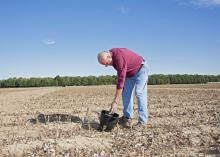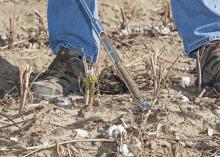Information Possibly Outdated
The information presented on this page was originally released on May 21, 2015. It may not be outdated, but please search our site for more current information. If you plan to quote or reference this information in a publication, please check with the Extension specialist or author before proceeding.
Actions, inactions impact soil health
STARKVILLE, Miss. -- Mississippi farmers should not take the state’s rich soil for granted, but the question of the best way to treat this valuable resource sparks debate.
“Soil can be thought of as a living organism that must be kept healthy to provide some of the crop requirements and make efficient use of inputs, especially fertilizer,” said Larry Oldham, soil specialist with the Mississippi State University Extension Service.
Oldham said fertilizers, pesticides and supplemental irrigation are major inputs in agriculture. Healthy soil reduces the need for these inputs, reducing the cost of crop production.
“Healthy soil has good structure, can manage water and is easily penetrated by roots,” Oldham said. “Soil health refers to the continued capacity of the soil to function as a vital living ecosystem that sustains plants, animals and humans.”
MSU soil scientists put a lot of effort into research that addresses the questions of how to achieve healthy soil and produce abundant crops.
Much of the debate over soil is driven by producers’ desire to maximize profit while getting the most out of their land in the form of high yields. Producers weigh the cost of more inputs to the soil against the return they will get from higher yields.
Billy Kingery, Mississippi Agricultural and Forestry Experiment Station soil scientist, said more attention should be given to whether a soil is healthy.
“Fertilizers replenish the nutrients that are taken from the soil when a crop is produced,” Kingery said. “Just replacing these lost nutrients by applying fertilizer each year is the most expensive option for making a crop because it ignores the soil’s ability to furnish those nutrients naturally.”
Healthy soil is necessary for plant roots to gain access to nutrients and water.
“More efficient use of nutrients in the soil and improved use of soil water should improve profitability,” Kingery said.
Producers may want to focus on what the soil needs for its own health rather than solely focusing on the production of a particular crop.
Cover crops aid in conservation by building soil health while contributing to the cash crop. Cover crops are grown in the off-season, usually over the winter, and help build the carbon content of the soil.
“Many cover crop roots exude carbon, and that attracts organisms that build the food chain and lead to the decomposition of residues so that when the cover crop is tilled into the ground, there is more carbon available to plants,” Kingery said. “Carbon glues soil particles together, so you get more efficient fertilizer use and better water-holding capacity.”
Compacted soil is another health issue. Soil is compacted when heavy machinery repeatedly runs over the same areas, pressing the soil particles together and removing the spaces in between that can hold moisture and nutrients and allow roots to penetrate. In the short term, mechanical subsoiling may be necessary. Longer term solutions are to avoid mechanical compaction and to foster microbial activity in the soil.
“Soil health is the intersection of the physical, biological and chemical state of the soil,” Oldham said. “All these go together in what determines the health of the soil.”
2015 has been designated the International Year of Soils, dedicated by the Food and Agriculture Organization and observed by a variety of organizations worldwide.







